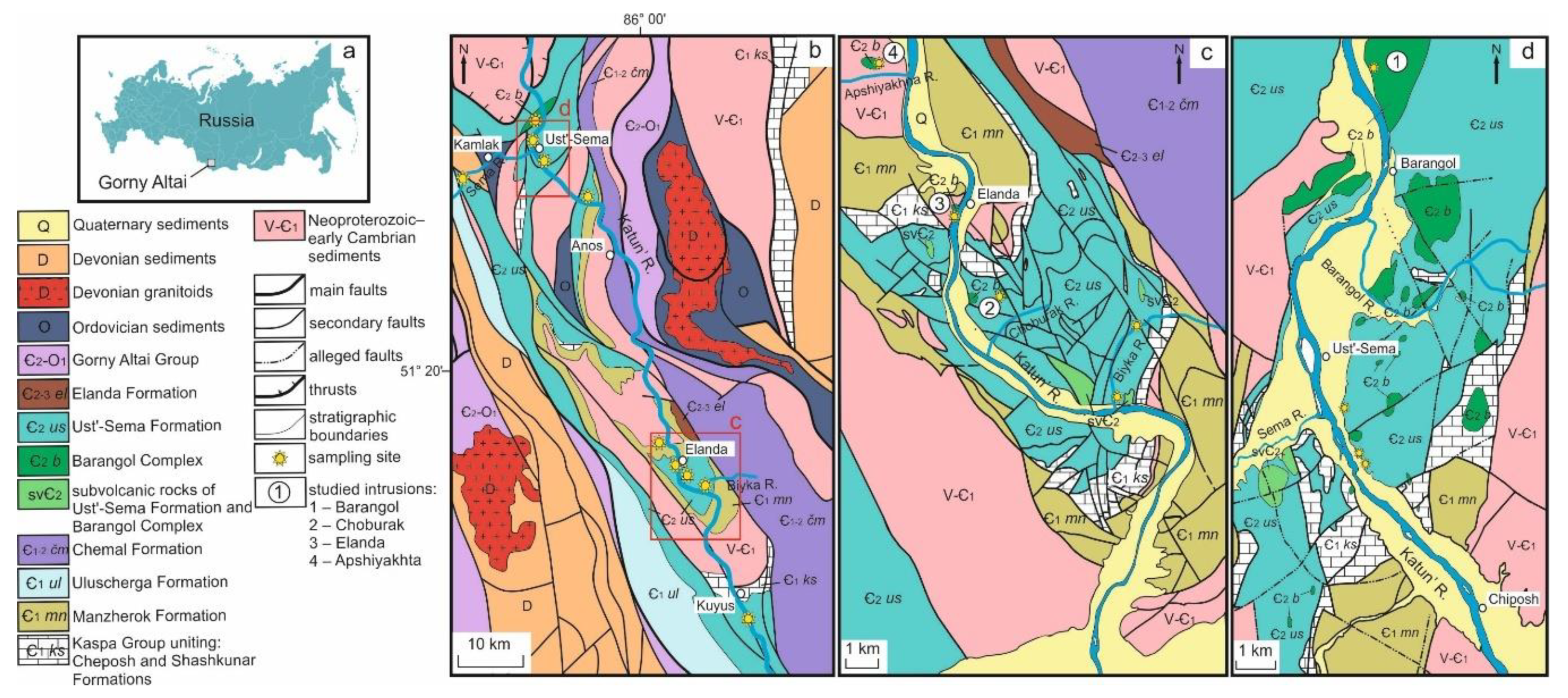Mineral Chemistry and Trace Element Composition of Clinopyroxenes from the Middle Cambrian Ust’-Sema Formation Ankaramites and Diopside Porphyry Basalts and the Related Barangol Complex Intrusions, Gorny Altai, Russia
Abstract
:1. Introduction
2. Geological Setting
3. Analytical Methods
4. Results
4.1. Petrography
4.1.1. The Ust’-Sema Formation Volcanic Rocks
4.1.2. The Intrusions of the Barangol Complex
4.2. Whole Rock Chemistry
4.3. Mineral Chemistry
4.3.1. Clinopyroxene
4.3.2. Plagioclase
4.3.3. Olivine
4.3.4. Amphibole
4.3.5. Cr-Spinel and Magnetite
4.4. Trace Elements in Clinopyroxene
5. Discussion
6. Conclusions
- Middle Cambrian Ust’-Sema Formation ankaramites and high-calcium diopside basalts have a single origin and a uniform magmatic source. The ankaramites were characterized by high contents of MgO (8.27–14.34 wt.%), CaO (12.09–14.48 wt.%) and a high CaO/Al2O3 ratio (1.1–1.6). The diopside porphyry basalts had low contents of CaO (9.79–11.86 wt.%) and MgO (6.35–7.84 wt.%), a low CaO/Al2O3 ratio (0.6–0.8), and a higher content of Al2O3 (13.74–16.67 wt.%).
- The Barangol Complex rocks were clinopyroxenite and gabbro and shared common features with the Ust’-Sema volcanic rocks, especially in the composition of clinopyroxene and Cr-spinel. These features are typical for subduction-related ankaramites worldwide and Ural–Alaskan-type intrusions.
- The cores of clinopyroxene phenocrysts were represented only by diopside in all types of rocks. The cores’ composition was characterized by increased Cr, Ni, and Mg contents. The cores sometimes have a complex structure with a large number of inclusions but, at the same time, are homogeneous in chemical composition, while the rims had a more variable composition and much fewer inclusions. The rims were characterized by higher Fe, Al, Na, Ti, Mn, V, and Zr contents. In areas with oscillatory zoning, the contents of these elements varied greatly, but they were always higher than in the cores.
- LA-ICP-MS analysis of the clinopyroxenes from both volcanic and intrusion rocks showed slight depletion of light rare-earth elements; strong depletion in high-field-strength (Zr, Hf, and Nb) and large-ion lithophile (Rb) elements and positive Sr anomaly.
- Major- and trace-element composition of the clinopyroxenes showed that the Ust’-Sema clinopyroxene cores were crystallized from the basaltic melt and were not from mantle paragenesis.
- The increased contents of Ti and incompatible elements in the rims of diopside phenocrysts from the Biyka volcano indicate a possible interaction of ankaramite-style magmas with high Ti melts or contamination with OIB-type rocks.
Supplementary Materials
Author Contributions
Funding
Acknowledgments
Conflicts of Interest
References
- Buslov, M.M.; Berzin, N.A.; Dobretsov, N.L.; Simonov, V.A. Geology and Tectonics of Gorny Altai; UIGGM: Novosibirsk, Russia, 1993; p. 122. [Google Scholar]
- Berzin, N.A.; Coleman, R.G.; Dobretsov, N.L.; Zonenshain, L.P.; Xiao, X.; Chang, E.Z. Geodynamic map of the western part of the Paleoasian Ocean. Russ. Geol. Geophys. 1994, 35, 8–28. [Google Scholar]
- Buslov, M.M.; Saphonova, I.Y.; Watanabe, T.; Obut, O.T.; Fujiwara, Y.; Iwata, K.; Semakov, N.N.; Sugai, Y.; Smirnova, L.V.; Kazansky, A.Y.; et al. Evolution of the Paleo-Asian Ocean (Altai–Sayan Region, Central Asia) and collision of possible Gondwana-derived terranes with the southern marginal part of the Siberian continent. Geosci. J. 2001, 5, 203–224. [Google Scholar] [CrossRef]
- Gibsher, A.S.; Esin, S.V.; Izokh, A.E.; Kireev, A.D.; Petrova, T.V. Cambrian diopside porphyry basalts of the Cheposh zone in Gorny Altai: A model for fractionation of hybrid magmas in intermediate magmatic chambers. Russ. Geol. Geophys. 1997, 38, 1789–1801. [Google Scholar]
- Dobretsov, N.L.; Buslov, M.M.; Safonova, I.Y.; Kokh, D.A. Fragments of oceanic islands in the Kurai and Katun’ accretionary wedges of Gorny Altai. Russ. Geol. Geophys. 2004, 45, 1381–1403. [Google Scholar]
- Zybin, V.A. Etalon of the Ust’-Sema Complex of Porphyric Basalts and Trachybasalts (Gorny Altai); SNIIGGiMS: Novosibirsk, Russia, 2006; p. 278. (In Russian) [Google Scholar]
- Simonov, V.A.; Safonova, I.Y.; Kovyazin, S.V.; Kurganskaya, E.V. Physic-chemical petrogenetic parameters of basaltic units in the Katun Zone of Gorny Altay. Litosfera 2010, 3, 111–117. (In Russian) [Google Scholar]
- Safonova, I.Y.; Buslov, M.M.; Simonov, V.A.; Izokh, A.E.; Komiya, T.; Kurganskaya, E.V.; Ohno, T. Geochemistry, petrogenesis and geodynamic origin of basalts from the Katun’ accretionary complex of Gorny Altai (southwestern Siberia). Russ. Geol. Geophys. 2011, 52, 421–442. [Google Scholar] [CrossRef]
- Kruk, N.N. Evolution Continental Crust and Granitoid Magmatism of Gorny Altai. Ph.D. Thesis, Sobolev Institute of Geology and Mineralogy, Novosibirsk, Russia, 2015. (In Russian). [Google Scholar]
- Khlif, N.; Vishnevskiy, A.V.; Izokh, A.E. Ankaramites of Gorny Altai: Mineralogical, petrographic and petrochemical features of diopside porphyry basalts of the Ust’-Sema Formation. Russ. Geol. Geophys. 2020, 61, 250–267. [Google Scholar] [CrossRef]
- Nisbet, E.G.; Pearce, J.A. Clinopyroxene composition in mafic lavas from different tectonic setting. Contrib. Mineral. Petrol. 1977, 63, 149–160. [Google Scholar] [CrossRef]
- Leterrier, J.; Maury, R.C.; Thonon, P.; Girard, D.; Marchal, M. Clinopyroxene composition as a method of identification of the magmatic affinities of paleo-volcanic series. Earth. Planet. Sci. Lett. 1982, 59, 139–154. [Google Scholar] [CrossRef]
- Beccaluva, L.; Macciotta, G.; Piccardo, G.B.; Zeda, O. Clinopyroxene composition of ophiolite basalts as petrogenetic indicator. Chem. Geol. 1989, 77, 165–182. [Google Scholar] [CrossRef]
- Aparicio, A. Relationship between clinopyroxene composition and the formation environment of volcanic host rocks. IUP J. Earth Sci. 2010, 4, 1–11. [Google Scholar]
- Jankovics, M.É.; Tarascák, Z.; Dobosi, G.; Embey-Isztin, A.; Batki, A.; Harangi, S.; Hauzenberger, C. Clinopyroxene with divers origin in alkali basalts from the western Pannonian Basin: Implications from trace element characteristics. Lithos 2016, 262, 120–134. [Google Scholar] [CrossRef]
- Batki, A.; Pál-Molnár, E.; Jankovics, M.É.; Kerr, A.C.; Kiss, B.; Markl, G.; Heincz, A.; Harangi, S. Insights into the evolution of an alkaline magmatic system: An in situ trace element study of clinopyroxenes from the Ditrău Alkaline Massif, Romania. Lithos 2018, 300–301, 51–71. [Google Scholar] [CrossRef] [Green Version]
- Zhang, Y.; Yu, K.; Qian, H. LA-ICP-MS analysis of clinopyroxenes in basaltic pyroclastic rocks from the Xisha Islands, Northwestern South China Sea. Minerals 2018, 8, 575. [Google Scholar] [CrossRef] [Green Version]
- Ubide, T.; Caulfield, J.; Brandt, C.; Bussweiler, Y.; Mollo, S.; Stefano, F.D.; Nazzari, M.; Scarlato, P. Deep magma storage revealed by multi-method elemental mapping of clinopyroxene megacrysts at Stromboli volcano. Front. Earth Sci. 2019, 7, 239. [Google Scholar] [CrossRef]
- Buslov, M.M.; Geng, H.; Travin, A.V.; Otgonbaatar, D.; Kulikova, A.V.; Chen, M.; Glorie, S.; Semakov, N.N.; Rubanova, E.S.; Abildaeva, M.A.; et al. Tectonics and geodynamics of Gorny Altai and adjacent structures of the Altai–Sayan Folded Area. Russ. Geol. Geophys. 2013, 54, 1250–1271. [Google Scholar] [CrossRef]
- State Geological Map of the Russian Federation, Scale 1: 1000 000, 3rd ed.; Series Altai-Sayansk, Sheet M-45 (Gorno-Altaysk); VSEGEI: St. Petersburg, Russian, 2011; p. 567. (In Russian)
- Shokalsky, S.P. Correlation of Magmatic and Metamorphic Complexes of the Western Part of the Altai-SAYAN Folded Region; GEO SB RAS: Novosibirsk, Russia, 2000; p. 188. (In Russian) [Google Scholar]
- State Geological Map of the Russian Federation, Scale 1: 200 000, 2nd ed.; Series Altai, Sheet M-45-VIII (Shebalino); VSEGEI: St. Petersburg, Russia, 2013; p. 242. (In Russian)
- Lavrent’ev, Y.G.; Karmanov, N.S.; Usova, L.V. Electron probe microanalysis of minerals: Microanalyzer or scanning electron microscope? Russ. Geol. Geophys. 2015, 56, 1154–1161. [Google Scholar] [CrossRef]
- Della-Pasqua, F.N.; Varne, R. Primitive ankaramitic magmas in volcanic arcs: A melt inclusion approach. Can. Mineral. 1997, 35, 291–312. [Google Scholar]
- Le Maitre, R.W. Igneous Rocks a Classification and Glossary of Terms Recommendations of the International Union of Geological Sciences, Sub-Commission on the Systematics of Igneous Rocks; Cambridge University Press: Cambridge, UK, 2002; 236p. [Google Scholar]
- Boynton, W.V. Cosmochemistry of the Rare Earth Elements: Meteorite Studies; Henderson, P., Ed.; Rare Earth Element Geochemistry; Elsevier: Amsterdam, The Netherlands, 1984; pp. 63–114. [Google Scholar]
- Morimoto, N. Nomenclature of Pyroxenes. Mineral. Petrol. 1988, 39, 55–76. [Google Scholar] [CrossRef]
- Leake, B.E. Nomenclature of amphiboles: Additions and revisions to the International Mineralogical Association’s amphibole nomenclature. Eur. J. Mineral. 2004, 16, 190–195. [Google Scholar] [CrossRef]
- Schulze, D. Origins of chromian and aluminous spinel macrocrysts from kimberlites in southern Africa. Can. Mineral. 2001, 39, 361–376. [Google Scholar] [CrossRef] [Green Version]
- Kamenetsky, V.S.; Crawford, A.J.; Meffre, S. Factors controlling the chemistry of magmatic spinel: An empirical study of associated olivine, Cr-spinel and melt inclusions from primitive rocks. J. Petrol. 2001, 42, 655–671. [Google Scholar] [CrossRef] [Green Version]
- Batanova, V.G.; Lyaskovskaya, Z.E.; Savelieva, G.N.; Sobolev, A.V. Peridotites from the Kamchatsky Mys: Evidence of oceanic mantle melting near a hotspot. Russ. Geol. Geophys. 2014, 55, 1395–1403. [Google Scholar] [CrossRef]
- Sun, S.S.; McDonough, W.F. Chemical and isotopic systematic of oceanic basalts: Implications for mantle composition and processes. In Magmatism in Ocean Basins; Sauders, A.D., Norry, M.J., Eds.; Geological Society London Special Publications: London, UK, 1989; pp. 313–345. [Google Scholar]
- Marchev, P.; Georgiev, S.; Zajacz, Z.; Manetti, P.; Raicheva, R.; Von Quadt, A.; Tommasini, S. High-K ankaramitic melt inclusions and lavas in the Upper Cretaceous Eastern Srednogorie continental arc, Bulgaria: Implication for the genesis of arc shoshonites. Lithos 2009, 113, 228–245. [Google Scholar] [CrossRef] [Green Version]
- Barasdell, M.; Berry, R.F. Origin and evolution of primitive island arc ankaramites from Western Epi, Vanuatu. J. Petrol. 1990, 31, 747–777. [Google Scholar] [CrossRef]
- Della-Pasqua, F.N. Primitive ankaramitic magmas in volcanic arcs: Evidence from melt inclusions. Ph.D. Thesis, University of Tasmania, Tasmania, Australia, 1997. [Google Scholar]
- Pushkarev, E.V.; Ryazancev, A.V.; Gottman, I.A. Ankaramites of Presakmara-Voznesenska zone of the Southern Urals- geological position and composition. In Yearbook Russian Academy of Sciences, Ural Branch, Institute of Geology and Geochemistry; IGG UB RAS: Yekaterinburg, Russia, 2017; Volume 164, pp. 166–175. (In Russian) [Google Scholar]
- Nimis, P. Clinopyroxene geobarometry of magmatic rocks. Part 2. Structural geobarometers for basic to acid, tholeiitic and mildly alkaline magmatic systems. Contrib. Mineral. Petrol. 1999, 135, 62–74. [Google Scholar] [CrossRef]
- Putirka, K.D. Thermometers and Barometers for volcanic systems. Rev. Mineral. Geochem. 2008, 69, 61–120. [Google Scholar] [CrossRef]
- Himmelberg, G.R.; Loney, R.A. Characteristics and Petrogenesis of Alaskan-Type Ultramafic–Mafic Intrusions, Southeastern Alaska; U.S. Geological Survey Professional Paper 1564; US Government Printing Office: Washington, DC, USA, 1995.
- Green, D.H.; Schmidt, M.W.; Hibberson, W.O. Island-arc ankaramites: Primitive melts from fluxed refractory lherzolitic mantle. J. Petrol. 2004, 45, 391–403. [Google Scholar] [CrossRef]
- Pushkarev, E.V. Petrology of the Uktus Dunite-Clinopyroxenite-Gabbro Massif (the Middle Urals); Russian Academy of Sciences, Ural Branch, Institute of Geology and Geochemistry: Ekaterinburg, Russia, 2000; p. 296. (In Russian) [Google Scholar]
- Khedr, M.; Arai, S. Petrology of a Neoproterozoic Alaskan-type complex from the Eastern Desert of Egypt: Implications for mantle heterogeneity. Lithos 2016, 263, 15–32. [Google Scholar] [CrossRef]
- Deng, Y.; Yuan, F.; Zhou, T.; Xu, C.; Zhang, D.; Guo, X. Geochemical characteristics and tectonic setting of the Tuerkubantao mafic-ultramafic intrusion in West Junggar, Xinjiang, China. Geosci. Front. 2015, 6, 141–152. [Google Scholar] [CrossRef] [Green Version]
- Kay, S.M.; Kay, R.W. Aleutian tholeiitic and calc-alkaline magma series I: The mafic phenocrysts. Contrib. Mineral. Petrol. 1985, 90, 276–290. [Google Scholar] [CrossRef]
- Singer, B.S.; Myers, J.D.; Frost, C.D. Mid-Pleistocene lavas from the Seguam volcanic center, central Aleutian arc: Closed system fractional crystallization of a basalt to rhyodacite eruptive suite. Contrib. Mineral. Petrol. 1992, 110, 87–112. [Google Scholar] [CrossRef]
- Le Bas, M.J. The role of aluminum in igneous clinopyroxenes with relation to their parentage. Am. J. Sci. 1962, 260, 267–288. [Google Scholar] [CrossRef]
- Loucks, R.R. Discrimination of ophiolitic from nonophiolitic ultramafic-mafic allochthons in erogenic belts by the Al/Ti ratio in clinopyroxene. Geol. J. 1990, 18, 346–349. [Google Scholar] [CrossRef]
- Yogodzinsky, G.M.; Kelemen, P.B. Slab melting in the Aleutians: Implications of an ion probe study of clinopyroxene in primitive adakite and basalt. Earth. Planet. Sci. Lett. 1998, 158, 53–65. [Google Scholar] [CrossRef]
- Izokh, A.E.; Vishnevskii, A.V.; Polyakov, G.V.; Kalugin, V.M.; Oyunchimeg, T.; Shelepaev, R.A.; Egorova, V.V. The Ureg Nuur Pt-bearing volcanoplutonic picrite–basalt association in the Mongolian Altay as evidence for a Cambrian–Ordovician Large Igneous Province. Russ. Geol. Geophys. 2010, 51, 521–533, 665–681. [Google Scholar] [CrossRef]
- Oyunchimeg, T.; Izokh, A.E.; Vishnevsky, A.V.; Kalugin, V.M. Isoferroplatinum mineral assemblage from the Burgastain Gol placer (Western Mongolia). Russ. Geol. Geophys. 2009, 50, 863–872, 1119–1130. [Google Scholar] [CrossRef]




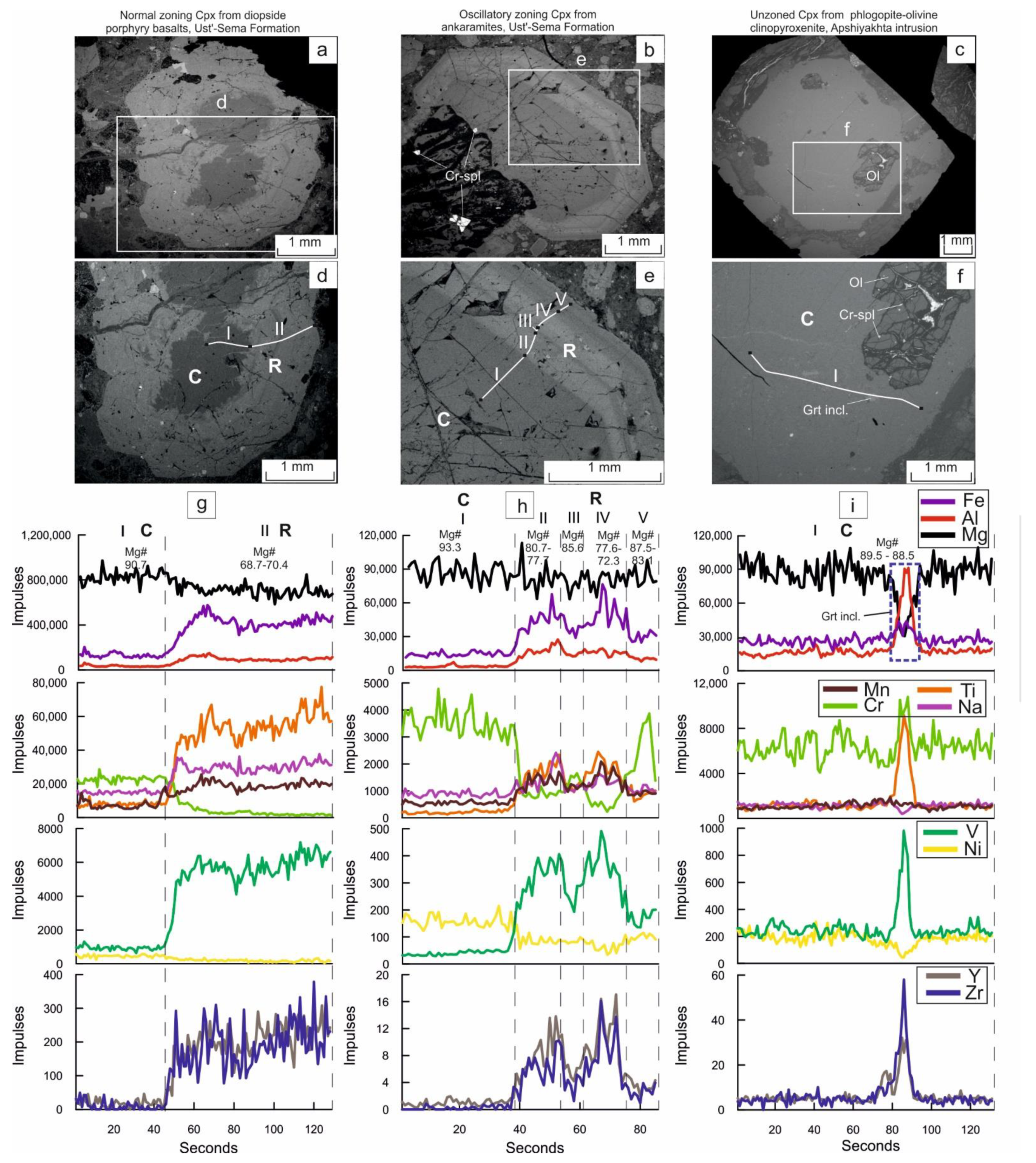
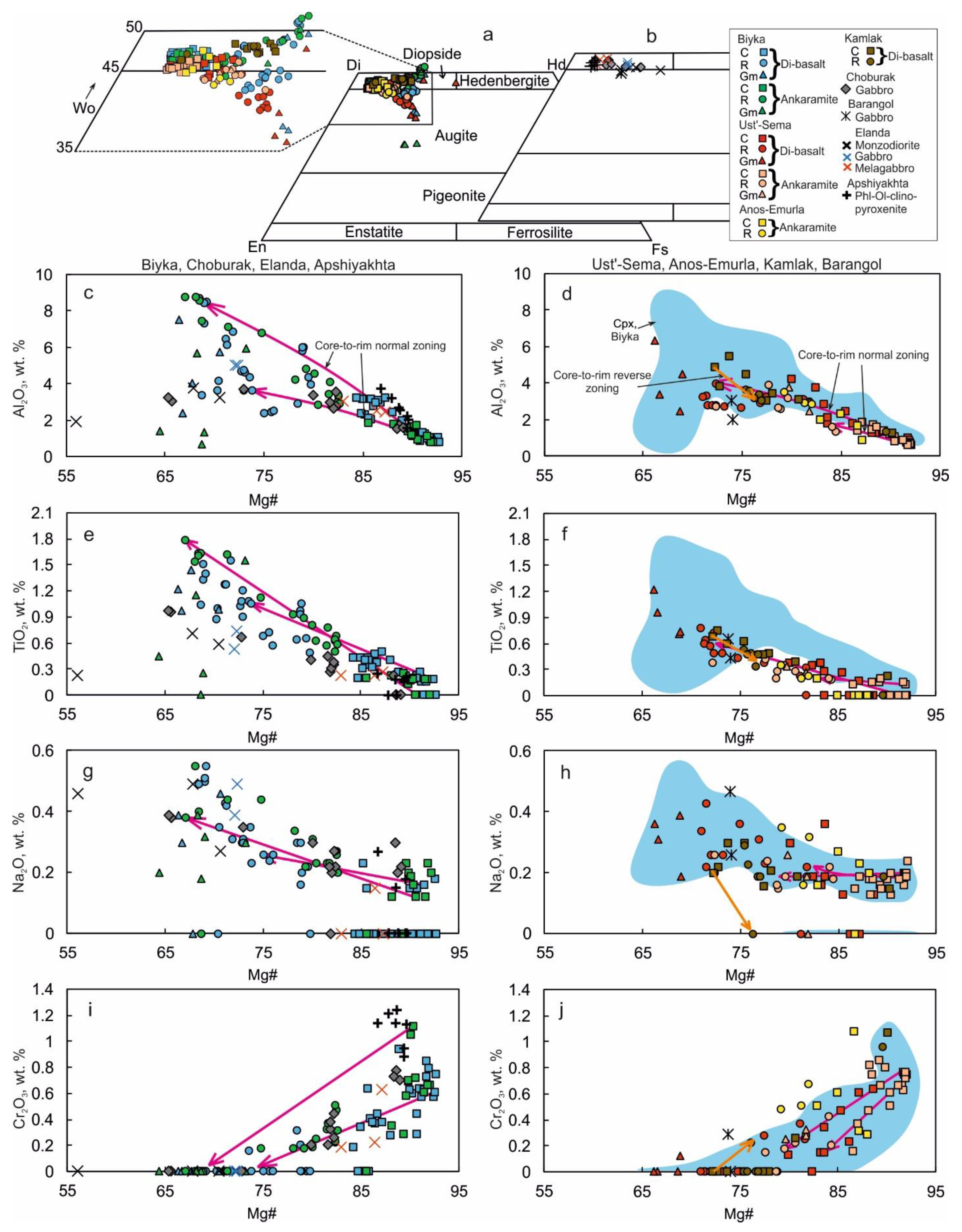

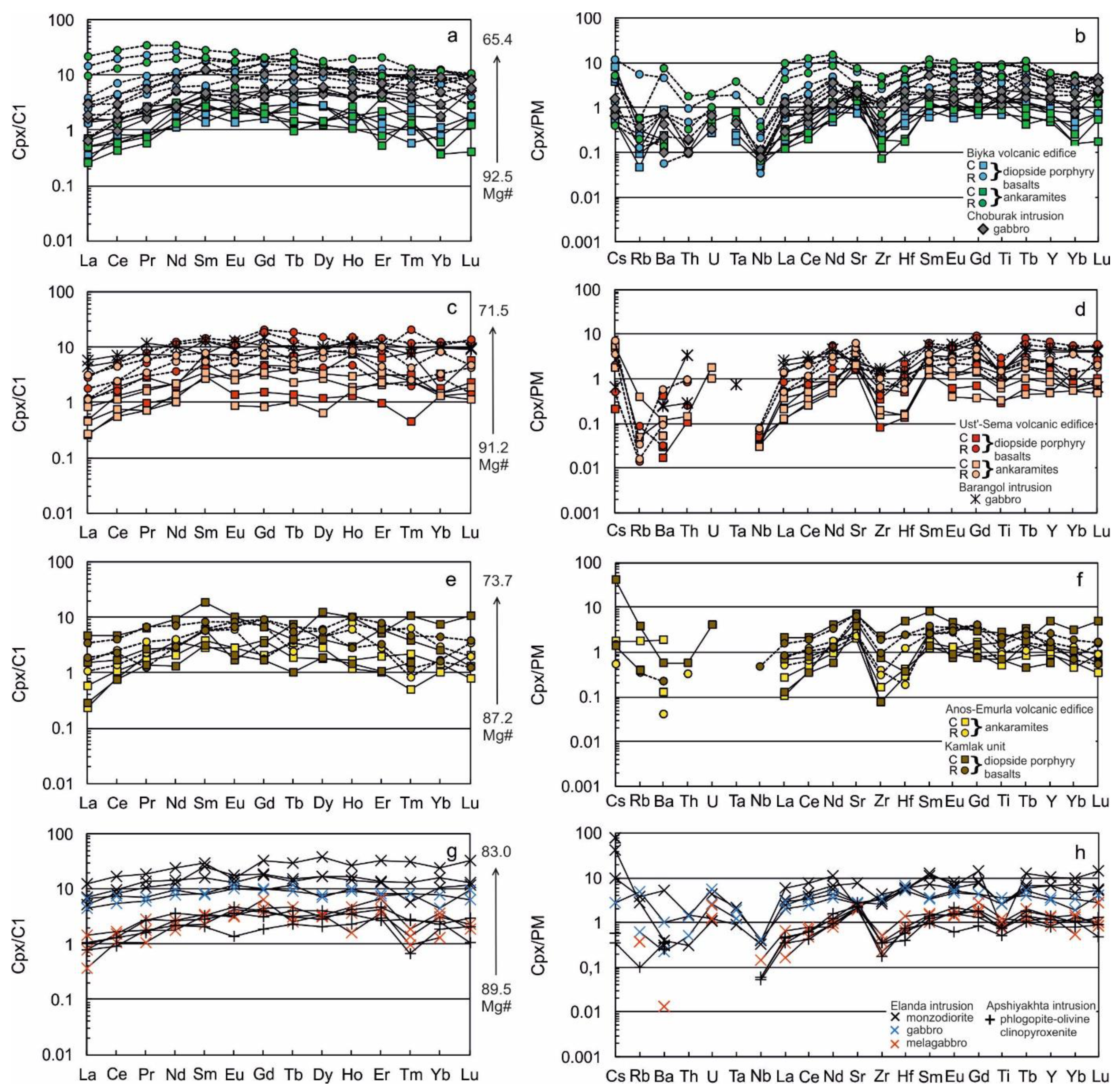

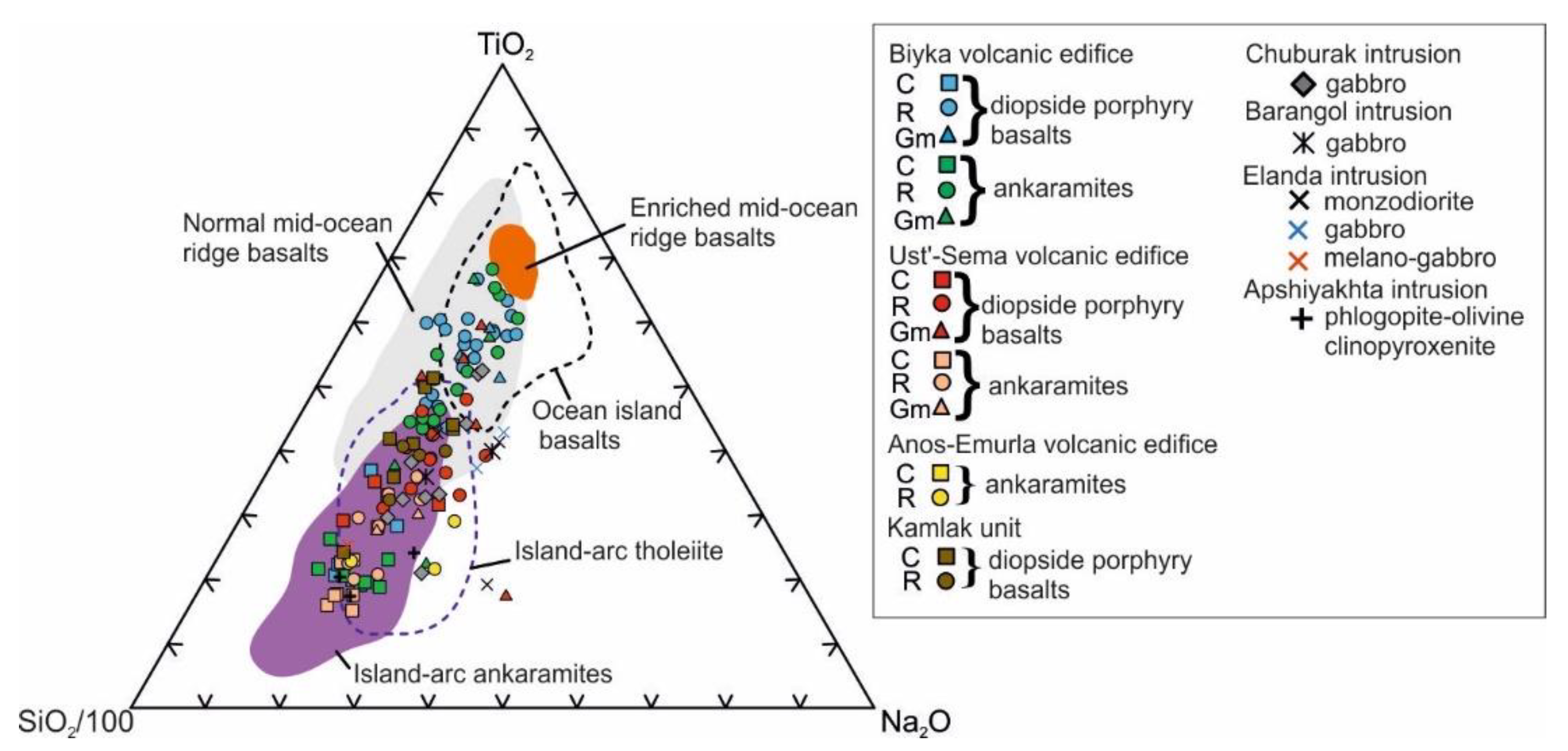
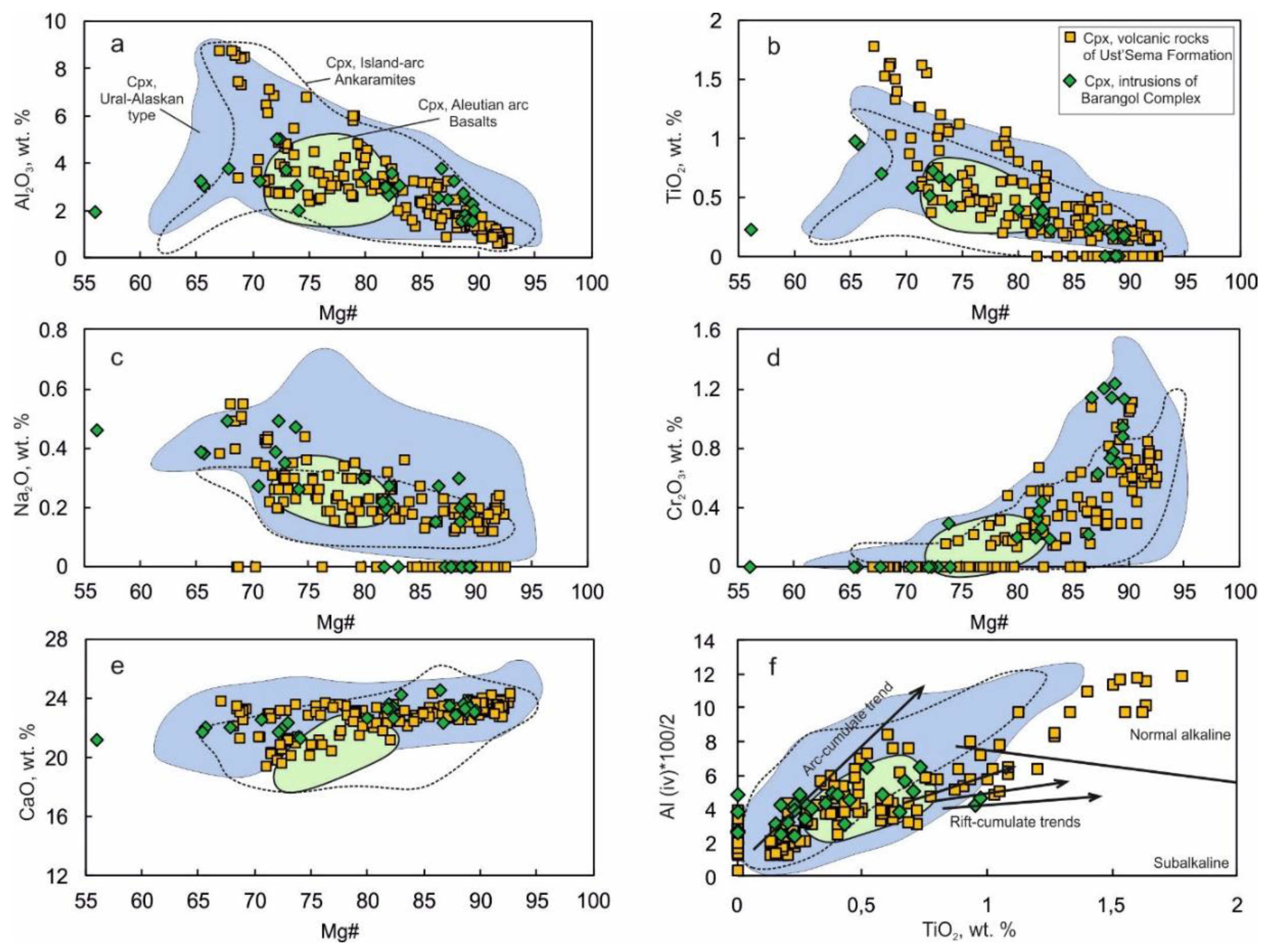

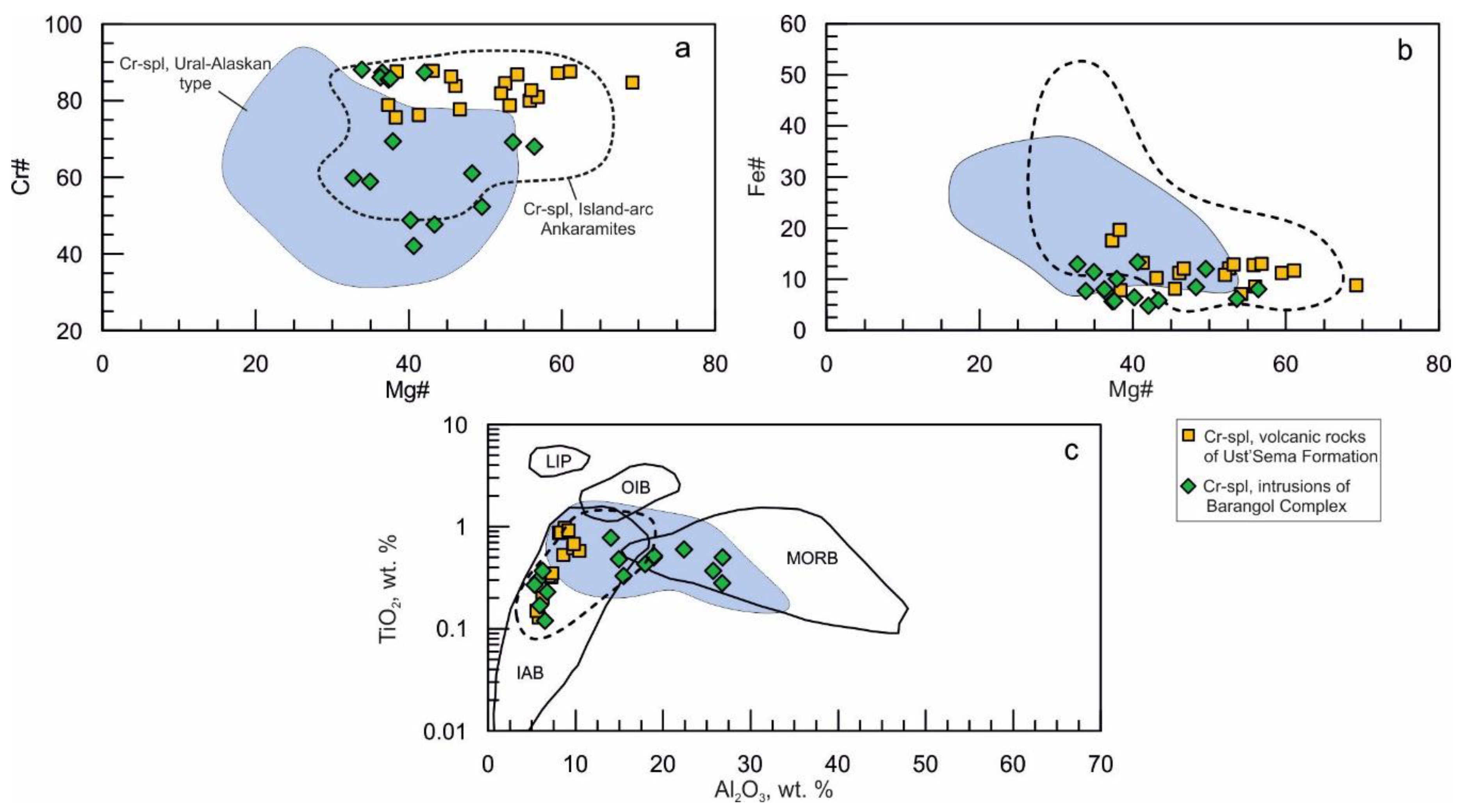
| Location | Rock Type | Sample | SiO2 | TiO2 | Al2O3 | Fe2O3 * | MnO | MgO | CaO | Na2O | K2O | P2O5 | Cr2O3 | LOI | Total | CaO/Al2O3 |
|---|---|---|---|---|---|---|---|---|---|---|---|---|---|---|---|---|
| Ust’-Sema Formation | ||||||||||||||||
| Biyka | Ankaramite | BIY-05-17 **(1) | 48.61 | 1.10 | 10.45 | 10.43 | 0.16 | 10.97 | 12.09 | 2.30 | 0.49 | 0.12 | 0.09 | 2.40 | 99.33 | 1.2 |
| BIY-04-17 ** | 44.78 | 1.05 | 13.41 | 10.95 | 0.20 | 8.27 | 14.48 | 0.77 | 1.07 | 0.37 | 0.03 | 3.37 | 99.88 | 1.1 | ||
| Di-basalt | BIY-02-18 | 47.98 | 1.11 | 13.74 | 11.25 | 0.18 | 7.84 | 11.56 | 2.28 | 0.31 | 0.16 | 0.04 | 3.22 | 99.87 | 0.8 | |
| BIY-01-02-17 ** | 46.37 | 1.00 | 15.80 | 9.74 | 0.16 | 7.03 | 11.86 | 1.78 | 1.63 | 0.12 | 0.05 | 3.68 | 99.53 | 0.8 | ||
| BIY-01-03-17 ** | 44.02 | 0.84 | 12.41 | 9.46 | 0.22 | 7.25 | 15.69 | 2.26 | 0.60 | 0.10 | 0.04 | 6.35 | 99.55 | 1.3 | ||
| BIY-01-04-17 ** | 43.66 | 0.82 | 13.26 | 8.90 | 0.22 | 5.42 | 16.84 | 2.20 | 0.13 | 0.17 | 0.03 | 7.47 | 99.39 | 1.3 | ||
| Ust’-Sema | Ankaramite | KAT-06-18 | 47.87 | 0.44 | 10.02 | 10.25 | 0.17 | 13.01 | 12.66 | 0.61 | 0.10 | 0.12 | 0.13 | 4.70 | 100.23 | 1.3 |
| Di-basalt | KAT-5-18 | 47.94 | 0.47 | 9.91 | 9.83 | 0.16 | 10.80 | 13.37 | 1.01 | 0.14 | 0.12 | 0.14 | 5.85 | 99.95 | 1.3 | |
| BAR-07-18 | 45.91 | 0.88 | 16.02 | 11.45 | 0.18 | 7.74 | 11.82 | 2.16 | 0.68 | 0.19 | 0.03 | 2.21 | 99.45 | 0.7 | ||
| BIY-07-17 | 49.07 | 0.69 | 16.67 | 9.87 | 0.17 | 6.35 | 9.79 | 2.79 | 1.09 | 0.20 | 0.02 | 2.64 | 99.47 | 0.6 | ||
| Anos-Emurla | Ankaramite | ANO-01-18 | 49.19 | 0.34 | 7.43 | 11.53 | 0.20 | 14.34 | 12.23 | 0.87 | 0.58 | 0.20 | 0.15 | 2.71 | 99.89 | 1.6 |
| Kamlak | Di-basalt | KAM-01-18 | 40.06 | 0.60 | 9.21 | 12.92 | 0.14 | 8.61 | 16.44 | 0.08 | 2.19 | 0.04 | 0.11 | 9.34 | 99.96 | 1.8 |
| Barangol Complex | ||||||||||||||||
| Elanda | Monzodiorite | ELN-01-17 | 49.60 | 0.51 | 21.13 | 8.40 | 0.15 | 2.68 | 7.23 | 3.45 | 3.41 | 0.24 | <0.01 | 2.61 | 99.57 | 0.3 |
| Gabbro | ELN-02-17 | 45.47 | 0.49 | 14.45 | 7.24 | 0.11 | 8.53 | 17.84 | 0.89 | 1.35 | 0.05 | <0.01 | 2.82 | 99.34 | 1.2 | |
| Melagabbro | ELN-03-17 | 47.52 | 0.44 | 9.46 | 9.10 | 0.16 | 12.42 | 16.44 | 1.32 | 0.84 | 0.09 | 0.06 | 2.10 | 100.04 | 1.7 | |
| Apshiyakhta | Phl-Ol clinopyroxenite | APSH-05-17 | 47.98 | 0.57 | 10.22 | 9.61 | 0.18 | 16.09 | 9.06 | 1.57 | 0.96 | 0.12 | 0.20 | 2.39 | 99.09 | 0.9 |
| Barangol | Gabbro | BAR-02-15 | 44.75 | 0.68 | 13.90 | 12.04 | 0.21 | 10.60 | 11.86 | 1.14 | 1.07 | 0.22 | 0.07 | 2.64 | 99.33 | 0.9 |
| Choburak | Gabbro | KAT-02-18 | 46.51 | 0.58 | 10.45 | 10.72 | 0.17 | 12.70 | 13.24 | 1.06 | 1.17 | 0.14 | 0.13 | 3.20 | 100.20 | 1.3 |
| Location | Biyka | Ust’-Sema | Anos-Emurla | |||||||
|---|---|---|---|---|---|---|---|---|---|---|
| Sample | BIY-01-02-17 | BIY-04-17 | KAT-05-18 | KAT-06-18 | ANO-01-18 | |||||
| Note | C | R | C | R | C | R | C | R | C | R |
| SiO2 (wt.%) | 50.75 | 48.58 | 53.78 | 45.93 | 53.48 | 52.46 | 54.10 | 50.96 | 51.99 | 51.45 |
| TiO2 | 0.43 | 1.02 | <dl | 1.63 | <dl | <dl | <dl | 0.42 | <dl | 0.23 |
| Al2O3 | 3.16 | 4.67 | 0.94 | 7.46 | 1.28 | 2.95 | 0.89 | 3.87 | 1.66 | 2.87 |
| Cr2O3 | 0.64 | <dl | 0.72 | <dl | 0.64 | 0.28 | 0.66 | 0.15 | 1.08 | 0.67 |
| FeO | 4.73 | 9.12 | 3.32 | 9.35 | 3.99 | 6.36 | 3.13 | 7.77 | 4.43 | 6.34 |
| MnO | <dl | 0.26 | <dl | 0.25 | <dl | 0.15 | <dl | 0.23 | <dl | 0.26 |
| MgO | 16.02 | 13.65 | 17.76 | 11.49 | 17.36 | 16.02 | 18.16 | 15.14 | 16.17 | 16.30 |
| CaO | 23.02 | 21.25 | 23.02 | 23.06 | 23.04 | 22.28 | 22.96 | 21.83 | 23.45 | 21.16 |
| Na2O | <dl | 0.30 | 0.12 | <dl | 0.13 | 0.22 | 0.18 | 0.24 | <dl | 0.32 |
| Total | 98.75 | 98.85 | 99.66 | 99.18 | 99.94 | 100.70 | 100.07 | 100.61 | 98.78 | 99.61 |
| Mg# | 85.7 | 72.8 | 90.6 | 68.7 | 88.6 | 81.8 | 91.2 | 77.7 | 86.7 | 82.0 |
| Fs | 7.6 | 15.0 | 5.1 | 15.7 | 6.2 | 10.0 | 4.8 | 12.4 | 7.0 | 10.2 |
| Wo | 47.0 | 44.9 | 45.8 | 49.8 | 45.8 | 45.0 | 45.3 | 44.6 | 47.5 | 43.4 |
| En | 45.5 | 40.1 | 49.1 | 34.5 | 48.0 | 45.0 | 49.8 | 43.0 | 45.5 | 46.5 |
| V (ppm) | 325.28 | 666.35 | 73.98 | 785.92 | 111.57 | 283.34 | 67.87 | 401.37 | 132.02 | 190.72 |
| Ni | 102.56 | 35.92 | 161.53 | 78.23 | 141.09 | 107.28 | 181.67 | 110.55 | 127.31 | 117.22 |
| Rb | 0.0580 | 0.0800 | <dl | 0.3440 | <dl | 0.0090 | 0.2540 | 0.0098 | 1.1200 | <dl |
| Sr | 19.01 | 24.96 | 29.25 | 162.22 | 33.81 | 34.5 | 43.96 | 100.77 | 49.96 | 57.66 |
| Y | 5.86 | 16.86 | 2.59 | 21.83 | 2.26 | 7.21 | 2.17 | 11.27 | 3.95 | 7.59 |
| Zr | 5.16 | 15.67 | 0.80 | 57.27 | 0.90 | 4.57 | <dl | 7.20 | 1.75 | 4.28 |
| Nb | 0.042 | 0.024 | <0,00 | 1.030 | 0.035 | <dl | 0.022 | <dl | <dl | <dl |
| Cs | 0.0159 | 0.0430 | 0.0260 | 0.1720 | 0.0068 | 0.0160 | 0.1750 | 0.1150 | 0.0570 | 0.0170 |
| Ba | 1.70 | 1.28 | <dl | 53.22 | 0.12 | <dl | 0.82 | 0.63 | 13.44 | 0.28 |
| La | 0.211 | 0.740 | 0.155 | 6.660 | 0.080 | 0.366 | 0.086 | 0.348 | 0.071 | 0.500 |
| Ce | 1.110 | 3.450 | 0.474 | 22.620 | 0.496 | 1.330 | 0.450 | 2.000 | 0.640 | 2.090 |
| Pr | 0.320 | 0.880 | 0.092 | 4.110 | 0.119 | 0.365 | 0.087 | 0.433 | 0.241 | 0.441 |
| Nd | 1.78 | 6.30 | 0.81 | 21.08 | 0.73 | 2.22 | 0.62 | 3.28 | 2.22 | 2.37 |
| Sm | 1.09 | 2.33 | 0.50 | 5.49 | 0.57 | 0.84 | <dl | 1.07 | 0.54 | 1.19 |
| Eu | 0.353 | 0.940 | 0.169 | 1.830 | 0.102 | 0.392 | 0.065 | 0.484 | 0.205 | 0.600 |
| Gd | 1.05 | 4.10 | 0.66 | 5.23 | 0.40 | 1.19 | 0.22 | 2.67 | 1.00 | 1.84 |
| Tb | 0.231 | 0.700 | 0.045 | 0.830 | 0.065 | 0.179 | 0.048 | 0.273 | 0.089 | 0.117 |
| Dy | 1.49 | 3.48 | 0.45 | 4.97 | 0.39 | 1.40 | 0.21 | 2.11 | 0.57 | 1.48 |
| Ho | 0.310 | 0.840 | 0.189 | 0.780 | 0.096 | 0.340 | 0.114 | 0.562 | 0.124 | 0.560 |
| Er | 0.87 | 1.99 | 0.11 | 2.05 | 0.21 | 0.48 | 0.49 | 0.95 | 0.42 | 1.19 |
| Tm | 0.090 | 0.293 | 0.051 | 0.310 | 0.015 | 0.064 | <dl | 0.085 | 0.070 | 0.203 |
| Yb | 0.590 | 1.430 | 0.077 | 2.620 | 0.270 | 0.600 | 0.680 | 0.680 | 0.300 | 0.620 |
| Lu | 0.048 | 0.289 | 0.013 | 0.309 | 0.048 | 0.047 | <dl | 0.134 | 0.025 | 0.063 |
| Hf | 0.312 | 1.050 | 0.063 | 2.210 | 0.041 | 0.370 | <dl | 0.245 | 0.129 | 0.055 |
| Ta | 0.0074 | <dl | <dl | 0.1590 | <dl | <dl | <dl | <dl | <dl | <dl |
| Th | <dl | <dl | <dl | 0.155 | 0.0089 | 0.022 | <dl | <dl | <dl | <dl |
| U | <dl | 0.0071 | <dl | 0.043 | <dl | <dl | 0.021 | <dl | <dl | <dl |
| (La/Yb)N | 0.2 | 0.3 | 1.4 | 1.7 | 0.2 | 0.4 | 0.1 | 0.3 | 0.2 | 0.5 |
| Eu/Eu* | 1.0 | 0.9 | 0.9 | 1.0 | 0.7 | 1.2 | <dl | 0.9 | 0.9 | 1.2 |
| Sample | KAM-01-18 | ELN-01-17 | ELN-02-17 | ELN-03-17 | APSH-05-17 | BAR-02-15 | KAT-02-18 | |||
| Note | C | R | C | C | C | C | C | C | R | |
| SiO2 (wt.%) | 48.35 | 50.00 | 51.00 | 48.44 | 52.41 | 53.48 | 51.15 | 50.87 | 50.04 | |
| TiO2 | 0.60 | 0.33 | 0.23 | 0.73 | 0.23 | 0.15 | 0.65 | 0.27 | 0.95 | |
| Al2O3 | 5.46 | 3.40 | 1.95 | 4.99 | 3.02 | 2.23 | 3.02 | 2.74 | 3.02 | |
| Cr2O3 | <dl | <dl | <dl | <dl | 0.19 | 0.94 | 0.29 | 0.32 | <dl | |
| FeO | 8.47 | 7.71 | 14.70 | 8.75 | 5.67 | 3.65 | 8.88 | 5.96 | 11.48 | |
| MnO | 0.18 | <dl | 0.50 | <dl | <dl | <dl | 0.28 | <dl | 0.34 | |
| MgO | 13.32 | 14.21 | 10.51 | 12.82 | 15.55 | 17.35 | 14.10 | 15.12 | 12.30 | |
| CaO | 23.53 | 23.63 | 21.20 | 21.95 | 24.25 | 22.96 | 21.39 | 23.56 | 21.98 | |
| Na2O | 0.30 | 0.19 | 0.46 | 0.49 | <dl | 0.18 | 0.47 | <dl | 0.38 | |
| Total | 100.20 | 99.47 | 100.56 | 98.16 | 101.34 | 100.93 | 100.39 | 98.84 | 100.49 | |
| Mg# | 73.7 | 76.7 | 56.0 | 72.3 | 83.0 | 89.5 | 73.9 | 81.9 | 65.7 | |
| Fs | 13.6 | 12.2 | 24.3 | 14.6 | 8.8 | 5.7 | 14.5 | 9.5 | 18.63 | |
| Wo | 48.4 | 47.8 | 44.8 | 47.1 | 48.2 | 46.0 | 44.6 | 47.8 | 45.75 | |
| En | 38.0 | 40.0 | 30.9 | 38.2 | 43.0 | 48.3 | 40.9 | 42.7 | 35.62 | |
| V (ppm) | 239.65 | 228.76 | 233.42 | 368.37 | 253.70 | 177.37 | 223.13 | 181.72 | 408.83 | |
| Ni | 129.83 | 118.50 | 15.61 | 82.73 | 102.83 | 240.08 | 119.70 | 118.86 | 88.39 | |
| Rb | 2.32 | 0.22 | <dl | 3.1 | <dl | <dl | <dl | <dl | 0.24 | |
| Sr | 146.42 | 148.13 | 44.64 | 55.35 | 46.42 | 46.89 | 46.98 | 43.06 | 53.86 | |
| Y | 21.66 | 11.90 | 48.29 | 14.69 | 5.94 | 3.60 | 18.71 | 6.87 | 17.22 | |
| Zr | 24.69 | 20.63 | 48.42 | 36.36 | 5.56 | 1.98 | 18.13 | 4.32 | 15.35 | |
| Nb | <dl | 0.33 | 0.28 | 0.30 | <dl | 0.038 | <dl | <dl | 0.08 | |
| Cs | 1.34 | <dl | 2.47 | 0.089 | <dl | 0.018 | <dl | <dl | 0.02 | |
| Ba | 3.94 | 1.54 | 2.11 | 7.05 | 0.09 | 2.49 | 1.62 | 0.70 | 5.37 | |
| La | 1.43 | 1.09 | 3.93 | 1.41 | 0.24 | 0.24 | 1.39 | 0.20 | 0.90 | |
| Ce | 3.84 | 3.25 | 13.36 | 4.39 | 1.22 | 0.75 | 4.40 | 0.80 | 2.40 | |
| Pr | 0.780 | 0.810 | 2.300 | 0.750 | 0.336 | 0.219 | 1.470 | 0.199 | 0.680 | |
| Nd | 5.45 | 4.32 | 14.68 | 4.77 | 1.57 | 1.28 | 6.16 | 1.56 | 5.01 | |
| Sm | 3.57 | 1.65 | 5.63 | 1.57 | 0.68 | 0.41 | 1.45 | 0.79 | 2.39 | |
| Eu | 0.750 | 0.600 | 1.140 | 0.860 | 0.233 | 0.103 | 0.980 | 0.217 | 0.600 | |
| Gd | 1.73 | 2.41 | 8.51 | 2.58 | 1.68 | 0.49 | 2.77 | 1.37 | 2.60 | |
| Tb | 0.191 | 0.320 | 1.370 | 0.436 | 0.120 | 0.108 | 0.510 | 0.186 | 0.492 | |
| Dy | 3.99 | 1.97 | 12.05 | 2.54 | 1.07 | 0.68 | 2.96 | 1.43 | 3.66 | |
| Ho | 0.730 | 0.740 | 1.960 | 0.670 | 0.333 | 0.167 | 0.860 | 0.281 | 0.668 | |
| Er | 1.11 | 1.65 | 7.04 | 1.77 | 1.40 | 0.61 | 2.15 | 1.06 | 1.52 | |
| Tm | 0.350 | 0.153 | 1.010 | 0.270 | 0.061 | 0.022 | 0.239 | 0.155 | 0.203 | |
| Yb | 1.53 | 0.94 | 4.95 | 0.95 | 0.75 | 0.40 | 2.00 | 0.61 | 1.94 | |
| Lu | 0.350 | 0.124 | 1.050 | 0.305 | 0.062 | 0.068 | 0.292 | 0.167 | 0.264 | |
| Hf | 1.440 | 0.730 | 1.680 | 2.080 | 0.420 | 0.233 | 0.420 | 0.440 | 0.730 | |
| Ta | <dl | <dl | 0.086 | 0.078 | <dl | <dl | 0.031 | <dl | 0.019 | |
| Th | 0.0480 | <dl | <dl | 0.1190 | <dl | <dl | 0.0250 | 0.0086 | 0.0160 | |
| U | 0.081 | <dl | 0.092 | 0.120 | <dl | <dl | <dl | <dl | <dl | |
| (La/Yb)N | 0.6 | 0.8 | 0.5 | 1.0 | 0.2 | 0.4 | 0.5 | 0.2 | 0.31 | |
| Eu/Eu* | 0.9 | 0.9 | 0.5 | 1.3 | 0.7 | 0.7 | 1.5 | 0.6 | 0.74 | |
| Analysis | SiO2 | Al2O3 | FeO | CaO | Na2O | K2O | Total | An |
|---|---|---|---|---|---|---|---|---|
| 1 | 50.53 | 31.06 | 1.40 | 14.16 | 3.24 | 0.39 | 100.78 | 69.2 |
| 2 | 54.20 | 28.90 | 0.58 | 9.88 | 4.81 | 0.90 | 99.27 | 50.3 |
| 3 | 48.71 | 31.72 | 1.12 | 15.62 | 2.60 | <dl | 99.77 | 76.9 |
| 4 | 52.24 | 29.34 | 0.99 | 12.48 | 4.26 | 0.29 | 99.61 | 60.8 |
| 5 | 52.20 | 28.57 | 1.48 | 12.13 | 4.37 | 0.45 | 99.19 | 59.0 |
| 6 | 51.45 | 29.63 | 1.33 | 13.39 | 3.63 | 0.36 | 99.78 | 65.7 |
| 7 | 54.87 | 28.88 | 0.58 | 9.73 | 4.84 | 1.11 | 100.01 | 49.1 |
| 8 | 50.30 | 25.87 | 2.28 | 17.25 | 3.61 | 0.41 | 100.00 | 71.1 |
| 9 | 57.63 | 26.70 | 0.48 | 8.51 | 6.61 | 0.58 | 100.50 | 40.2 |
| 10 | 61.27 | 24.83 | 0.37 | 2.88 | 8.09 | 2.40 | 99.84 | 14.2 |
| Analysis | SiO2 | FeO | MnO | MgO | CaO | NiO | Total | Fo |
|---|---|---|---|---|---|---|---|---|
| 1 | 39.62 | 13.21 | <dl | 46.37 | <dl | 0.36 | 99.56 | 86.2 |
| 2 | 39.11 | 13.25 | 0.25 | 45.72 | <dl | 0.41 | 98.73 | 86.0 |
| 3 | 39.30 | 15.18 | 0.25 | 44.74 | 0.13 | 0.25 | 99.85 | 84.0 |
| 4 | 40.20 | 15.46 | 0.34 | 45.27 | 0.14 | 0.33 | 101.74 | 83.9 |
| 5 | 39.86 | 15.94 | 0.26 | 44.97 | 0.00 | 0.20 | 101.23 | 83.4 |
| 6 | 39.19 | 15.34 | 0.22 | 45.19 | 0.13 | 0.29 | 100.35 | 84.0 |
| 7 | 39.79 | 15.89 | 0.28 | 45.42 | 0.13 | 0.28 | 101.79 | 83.6 |
| 8 | 40.22 | 14.61 | 0.28 | 46.27 | 0.29 | 0.24 | 101.92 | 85.0 |
| 9 | 39.77 | 14.37 | 0.31 | 46.23 | 0.22 | 0.32 | 101.23 | 85.2 |
| 10 | 38.72 | 14.42 | 0.28 | 44.59 | 0.10 | 0.31 | 98.42 | 84.6 |
| 11 | 39.60 | 14.40 | 0.34 | 45.47 | 0.15 | 0.27 | 100.22 | 84.9 |
| Analysis | TiO2 | Al2O3 | Cr2O3 | FeO * | Fe2O3 * | MgO | Total | Cr# | Mg# | Fe# | Mg#Cpx, FoOl | Note |
|---|---|---|---|---|---|---|---|---|---|---|---|---|
| 1 | 0.13 | 5.78 | 58.67 | 14.41 | 9.19 | 11.54 | 99.80 | 87.2 | 59.5 | 11.2 | 92.8 (Mg#) | Cr-spl |
| 2 | 0.15 | 5.56 | 58.43 | 13.67 | 9.54 | 11.67 | 99.42 | 87.6 | 61.1 | 11.7 | 92.8 (Mg#) | Cr-spl |
| 3 | 0.53 | 8.62 | 47.93 | 22.61 | 14.26 | 7.21 | 100.22 | 78.9 | 37.3 | 17.6 | 82.7 (Mg#) | Cr-spl |
| 4 | 0.62 | 9.75 | 45.09 | 22.69 | 16.14 | 7.50 | 100.56 | 75.6 | 38.3 | 19.6 | 82.7 (Mg#) | Cr-spl |
| 5 | <dl | 5.48 | 58.74 | 20.35 | 8.25 | 8.41 | 100.40 | 87.8 | 43.1 | 10.3 | 89.1 (Mg#) | Cr-spl |
| 6 | 0.32 | 7.24 | 56.04 | 19.60 | 9.12 | 9.14 | 100.82 | 83.8 | 46.1 | 11.2 | 91.8 (Mg#) | Cr-spl |
| 7 | 0.33 | 6.92 | 56.37 | 17.64 | 9.94 | 10.63 | 100.84 | 84.5 | 52.6 | 12.1 | 90.7 (Mg#) | Cr-spl |
| 8 | 0.58 | 10.43 | 49.93 | 21.94 | 10.81 | 8.37 | 100.98 | 76.3 | 41.3 | 13.2 | altered Cpx | Cr-spl |
| 9 | 0.68 | 9.81 | 51.17 | 19.88 | 9.78 | 9.45 | 99.79 | 77.8 | 46.7 | 12.1 | altered Cpx | Cr-spl |
| 10 | <dl | 6.29 | 61.80 | 16.77 | 5.79 | 10.93 | 100.99 | 86.8 | 54.2 | 7.1 | altered Cpx | Cr-spl |
| 11 | <dl | 5.69 | 60.09 | 21.87 | 6.27 | 7.50 | 100.77 | 87.6 | 38.4 | 7.9 | altered Cpx | Cr-spl |
| 12 | 0.87 | 8.12 | 54.78 | 17.86 | 8.77 | 10.58 | 100.75 | 81.9 | 52.1 | 10.8 | 90.8 (Mg#) | Cr-spl |
| 13 | 0.97 | 8.77 | 52.27 | 16.53 | 10.34 | 11.33 | 99.68 | 80.0 | 55.8 | 12.7 | 90.4 (Mg#) | Cr-spl |
| 14 | 0.88 | 8.31 | 52.62 | 15.81 | 10.56 | 11.29 | 99.51 | 80.9 | 56.8 | 13.0 | 90.4 (Mg#) | Cr-spl |
| 15 | 0.92 | 9.20 | 50.92 | 17.10 | 10.38 | 10.53 | 98.89 | 78.8 | 53.2 | 12.9 | 90.4 (Mg#) | Cr-spl |
| 16 | 0.20 | 6.22 | 58.42 | 19.88 | 6.41 | 9.12 | 101.01 | 86.3 | 45.5 | 8.1 | Gm | Cr-spl |
| 17 | 0.00 | 8.24 | 58.84 | 15.31 | 7.15 | 10.68 | 103.33 | 82.7 | 56.0 | 8.6 | Gm | Cr-spl |
| 18 | 0.35 | 7.33 | 60.60 | 11.97 | 7.40 | 14.74 | 102.26 | 84.7 | 69.2 | 8.8 | Gm | Cr-spl |
| 19 | 0.30 | 5.71 | 58.77 | 22.72 | 5.77 | 7.20 | 100.15 | 87.4 | 36.5 | 7.4 | 71.4 (Mg#) | Cr-spl |
| 20 | 0.37 | 6.25 | 57.81 | 22.97 | 6.26 | 7.18 | 100.44 | 86.1 | 36.3 | 8.0 | 71.4 (Mg#) | Cr-spl |
| 21 | 0.27 | 5.31 | 58.76 | 23.48 | 5.93 | 6.62 | 100.02 | 88.1 | 33.9 | 7.7 | altered Cpx | Cr-spl |
| 22 | 0.60 | 22.41 | 36.61 | 19.61 | 10.32 | 10.46 | 99.41 | 52.3 | 49.6 | 12.0 | 86.8 (Mg#) | Cr-spl |
| 23 | 0.48 | 14.96 | 50.13 | 17.46 | 5.05 | 11.14 | 99.16 | 69.2 | 53.6 | 6.2 | 89.8 (Mg#) | Cr-spl |
| 24 | 0.50 | 18.95 | 44.17 | 19.76 | 7.17 | 10.12 | 100.76 | 61.0 | 48.3 | 8.5 | 89.7 (Mg#) | Cr-spl |
| 25 | 0.33 | 15.49 | 49.01 | 16.28 | 6.76 | 11.56 | 99.90 | 68.0 | 56.4 | 8.0 | 90.1 (Mg#) | Cr-spl |
| 26 | 0.78 | 14.04 | 47.34 | 23.21 | 8.20 | 7.76 | 101.05 | 69.4 | 37.9 | 10.0 | 84.9 (Fo) | Cr-spl |
| 27 | 0.23 | 6.76 | 59.38 | 21.82 | 4.46 | 7.20 | 100.02 | 85.5 | 37.4 | 5.7 | 84.9 (Fo) | Cr-spl |
| 28 | 0.17 | 5.93 | 61.36 | 20.29 | 3.79 | 8.16 | 99.66 | 87.4 | 42.0 | 4.8 | 84.9 (Fo) | Cr-spl |
| 29 | 0.12 | 6.52 | 58.71 | 21.67 | 4.42 | 7.23 | 99.54 | 85.8 | 37.6 | 5.7 | 84.9 (Fo) | Cr-spl |
| 30 | 0.37 | 25.73 | 36.54 | 22.98 | 5.49 | 8.54 | 99.97 | 48.8 | 40.2 | 6.4 | 83.9 (Fo) | Cr-spl |
| 31 | 0.50 | 26.81 | 36.39 | 21.30 | 5.05 | 9.00 | 99.59 | 47.7 | 43.4 | 5.9 | 83.9 (Fo) | Cr-spl |
| 32 | 0.52 | 18.97 | 40.46 | 24.87 | 9.55 | 7.28 | 100.95 | 58.9 | 34.9 | 11.4 | 84.0 (Fo) | Cr-spl |
| 33 | 0.43 | 17.97 | 39.83 | 25.12 | 10.73 | 6.63 | 100.34 | 59.8 | 32.8 | 12.9 | 84.0 (Fo) | Cr-spl |
| 34 | 0.28 | 26.77 | 29.04 | 23.12 | 11.52 | 8.59 | 98.49 | 42.1 | 40.6 | 13.3 | 84.0 (Fo) | Cr-spl |
| 35 | 2.12 | <dl | 3.39 | 32.92 | 60.02 | <dl | 93.57 | nc | nc | nc | 80.1 (Mg#) | Mag |
| 36 | 1.12 | <dl | 3.38 | 33.36 | 63.74 | <dl | 95.65 | nc | nc | nc | Gm | Mag |
| 37 | 4.35 | <dl | 2.12 | 36.52 | 58.92 | <dl | 96.49 | nc | nc | nc | Gm | Mag |
| 38 | 4.32 | <dl | 1.67 | 35.74 | 59.35 | <dl | 95.90 | nc | nc | nc | Gm | Mag |
| 39 | <dl | 2.40 | 34.76 | 27.45 | 31.46 | <dl | 99.40 | nc | nc | nc | Gm | Mag |
| 40 | <dl | 1.59 | 30.63 | 27.48 | 36.57 | <dl | 98.61 | nc | nc | nc | Gm | Mag |
Publisher’s Note: MDPI stays neutral with regard to jurisdictional claims in published maps and institutional affiliations. |
© 2022 by the authors. Licensee MDPI, Basel, Switzerland. This article is an open access article distributed under the terms and conditions of the Creative Commons Attribution (CC BY) license (https://creativecommons.org/licenses/by/4.0/).
Share and Cite
Khlif, N.; Vishnevskiy, A.; Izokh, A.; Chervyakovskaya, M. Mineral Chemistry and Trace Element Composition of Clinopyroxenes from the Middle Cambrian Ust’-Sema Formation Ankaramites and Diopside Porphyry Basalts and the Related Barangol Complex Intrusions, Gorny Altai, Russia. Minerals 2022, 12, 113. https://doi.org/10.3390/min12020113
Khlif N, Vishnevskiy A, Izokh A, Chervyakovskaya M. Mineral Chemistry and Trace Element Composition of Clinopyroxenes from the Middle Cambrian Ust’-Sema Formation Ankaramites and Diopside Porphyry Basalts and the Related Barangol Complex Intrusions, Gorny Altai, Russia. Minerals. 2022; 12(2):113. https://doi.org/10.3390/min12020113
Chicago/Turabian StyleKhlif, Nezar, Andrey Vishnevskiy, Andrey Izokh, and Maria Chervyakovskaya. 2022. "Mineral Chemistry and Trace Element Composition of Clinopyroxenes from the Middle Cambrian Ust’-Sema Formation Ankaramites and Diopside Porphyry Basalts and the Related Barangol Complex Intrusions, Gorny Altai, Russia" Minerals 12, no. 2: 113. https://doi.org/10.3390/min12020113
APA StyleKhlif, N., Vishnevskiy, A., Izokh, A., & Chervyakovskaya, M. (2022). Mineral Chemistry and Trace Element Composition of Clinopyroxenes from the Middle Cambrian Ust’-Sema Formation Ankaramites and Diopside Porphyry Basalts and the Related Barangol Complex Intrusions, Gorny Altai, Russia. Minerals, 12(2), 113. https://doi.org/10.3390/min12020113





